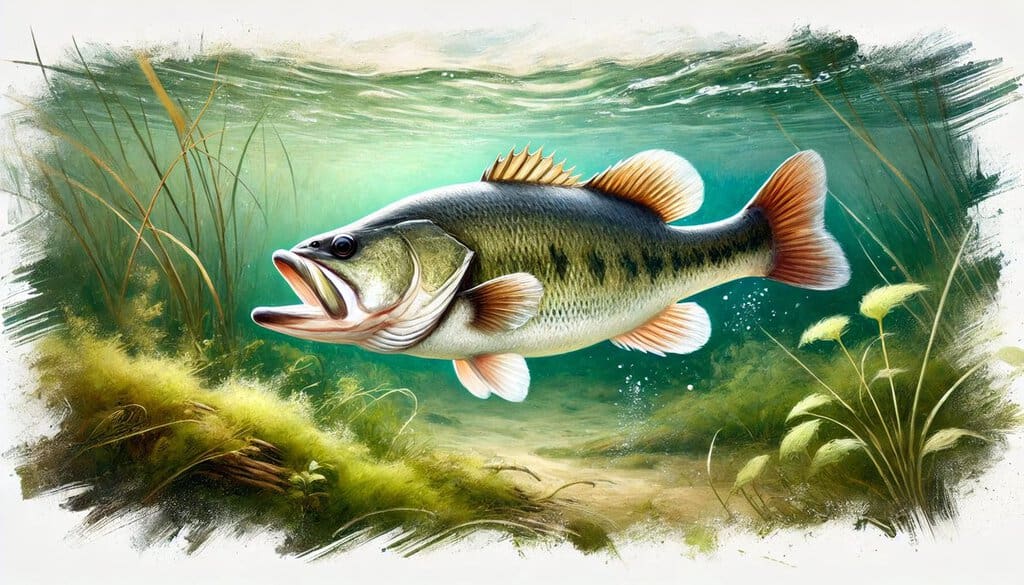Largemouth Bass (Micropterus nigricans) is a popular species for aquaponics due to its adaptability and potential for both recreational and commercial use. This fish is known for its resilience and ability to thrive in various environments, making it an attractive option for aquaponics enthusiasts[1][3].
Natural Habitat and Behavior
Origin and native environment: Largemouth Bass are naturally found in rivers, lakes, and ponds across North America[6]. They are adaptable to various aquatic environments, including both main-channel and off-channel habitats in large river systems[6].
Natural behavior in the wild: In their natural habitat, Largemouth Bass exhibit seasonal movement patterns, using off-channel habitats extensively during winter and spring for spawning[6]. They are known to be sit-and-wait predators, which influences their behavior in captivity[4].
Temperament: In aquaponics systems, Largemouth Bass may display territorial behavior, especially as they grow larger. Their sit-and-wait predatory nature may influence their interactions within the system[4].
Compatibility: Due to their predatory nature, Largemouth Bass are generally not recommended to be kept with other fish species in aquaponics systems. They are best suited for single-species setups[1].
Water Requirements
Temperature Range:
- Ideal temperature: 20-30°C (68-86°F)[3]
- High temperatures (around 30°C or 86°F) can impact growth and require adjusted feeding strategies[3]
pH Level:
- Recommended pH range: 6.5-8.5
- Largemouth Bass can tolerate a range of pH levels, but stability is important for optimal health
Oxygen Levels:
- Largemouth Bass require well-oxygenated water
- Ideal dissolved oxygen levels should be maintained above 5 mg/L
Ammonia/Nitrate Sensitivity:
- Largemouth Bass are sensitive to high levels of ammonia and nitrites
- Regular water quality monitoring is essential to prevent stress and health issues
Tank or Pond Setup
Tank/Pond Size Requirements:
- Minimum recommended tank size: 500 L (132 gallons) per group of fish[1]
- Stocking density: Studies have used densities ranging from 4.23 kg/m³ to 8.05 kg/m³ (0.26-0.50 lbs/ft³)[1]
Filtration & Aeration:
- Efficient filtration and strong aeration are crucial for maintaining water quality
- Largemouth Bass require well-oxygenated water, so adequate circulation is essential
Tank Decorations/Substrate:
- Incorporate structures that mimic natural habitats, such as artificial vegetation or hides
- These additions can provide shelter and reduce stress for the fish
Feeding Requirements
Diet:
- Largemouth Bass are carnivorous
- They can be fed commercial pellet food formulated for predatory fish[3]
Feeding Techniques:
- Feeding frequency may vary based on water temperature and fish size
- In high-temperature conditions (30°C or 86°F), feeding at 3% body weight daily or feeding to satiation every second day has shown efficient growth[3]
Growth and Reproduction
Growth Rate:
- Growth rates can vary depending on feeding regimes and environmental conditions
- In one study, fingerlings grew from an initial weight of 12.7 g to a final average weight of 263 g over 70 days[1][3]
Breeding Behavior:
- Largemouth Bass typically spawn in spring
- In natural environments, they prefer off-channel habitats for spawning[6]
- Breeding in aquaponics systems may be challenging and is not commonly practiced
Harvesting & Culinary Considerations
Growth to Harvest:
- Time to harvest size can vary greatly depending on initial size, feeding, and system conditions
- In the study mentioned, fish reached an average of 263 g after 70 days[1]
Culinary Uses:
- Largemouth Bass is valued for its firm, white flesh
- It can be prepared in various ways, including grilling, frying, or baking
Pros and Cons
- Adaptable to various aquatic environments
- Potential for both recreational and commercial use
- Resilient species that can tolerate a range of water conditions
- Slower growth rates compared to some other aquaponics species
- May require specialized feeding regimes, especially in high-temperature conditions
- Not suitable for multi-species setups due to predatory nature
Overall Suitability: Best suited for experienced aquaponics practitioners or those interested in single-species systems. May be more challenging for beginners due to specific care requirements
Common Health Issues and Solutions
Potential Diseases:
- Susceptible to common fish diseases such as ich, fungal infections, and bacterial infections
- Stress from poor water quality or overcrowding can lead to health issues
Signs of Health Issues:
- Look for changes in behavior, loss of appetite, abnormal swimming patterns, or visible lesions
Treatment Recommendations:
- Maintain optimal water quality through regular testing and water changes
- Consult with a fish health professional for specific treatment options if issues arise
Maintenance Tips for Long-Term Health
Maintenance Frequency:
- Regular water quality testing is essential
- Perform water changes as needed to maintain optimal conditions
System checks:
- Monitor temperature, dissolved oxygen, pH, and ammonia/nitrite levels regularly
- Ensure proper functioning of aeration and filtration systems
Handling Practices:
- Minimize handling to reduce stress
- Use appropriate nets and techniques when moving fish is necessary
Closing Thoughts
Largemouth Bass can be a rewarding species for aquaponics, particularly for those interested in raising a native North American fish. While they present some challenges in terms of growth rates and specific care requirements, their adaptability and potential for both food and recreational use make them an interesting option for experienced aquaponics practitioners. Success with Largemouth Bass in aquaponics requires careful attention to water quality, feeding regimes, and system design to mimic their natural habitat preferences.
Other fish species for aquaponics
External sources:
[1] https://www.semanticscholar.org/paper/ef6e8dd43747ca6484dd022b61366bb783d38f2e
[2] https://www.semanticscholar.org/paper/ac0da10a016757798c9f646e2d84f88ce28864d6
[3] https://www.ncbi.nlm.nih.gov/pmc/articles/PMC9597755/
[4] https://www.semanticscholar.org/paper/1f38ed191e309e19637b0cd110be06a08b95be63
[5] https://www.semanticscholar.org/paper/4260a61eb39f8344421ed54103d4b8d16fed88c1
[6] https://www.semanticscholar.org/paper/bf81bbb0738d6395bbfe3b45418259d606705408

